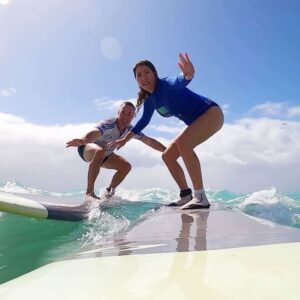Are you dreaming of riding the waves in the tropical paradise of Hawaii? If so, you’re not alone! Learning to surf in Hawaii is a dream for many, and luckily, it’s an achievable dream. In this article, we’ll explore some of the best ways you can learn to surf in Hawaii, whether you’re a beginner or have some experience under your belt. From finding the right surf school to choosing the perfect beach for beginners, we’ll cover everything you need to know to make your surfing dreams a reality. So grab your board and let’s dive into the world of surfing in Hawaii!
Choose the Right Time to Visit
Consider the surf season
When planning your trip to Hawaii to learn how to surf, it’s important to consider the surf season. Different islands in Hawaii experience surf swells at different times throughout the year. For example, the North Shore of Oahu is known for its massive waves during the winter months, which may not be suitable for beginners. On the other hand, summer months generally bring smaller and more manageable waves for beginners to learn how to surf. So, be sure to research the surf season of your destination island to choose the right time for your surfing adventure.
Avoid the busy tourist season
Another factor to consider when planning your surfing trip to Hawaii is to avoid the busy tourist season. Not only will the beaches be more crowded, but the surf schools and instructors may also be fully booked during peak tourist times. It’s generally best to avoid school holidays and major events when planning your trip. By selecting a less crowded time to visit, you’ll have more availability to book lessons and enjoy a more relaxed environment to learn how to surf.
Check for optimal conditions
In addition to considering the surf season and avoiding the busy tourist season, it’s crucial to check for optimal surf conditions when planning your lessons. While some days may have great weather, certain factors like wind direction, tides, and swell size can affect the quality of the waves for learning to surf. Research the local surf reports and consult with your surf school to ensure you’re booking lessons on days with ideal conditions. This will enhance your learning experience and increase your chances of catching great waves during your lessons.
Selecting the Ideal Surf School
Research reputable surf schools
With the popularity of surfing in Hawaii, there are numerous surf schools to choose from. However, not all surf schools are created equal. It’s essential to conduct thorough research to find reputable surf schools. Look for schools that have a good reputation, positive reviews, and qualified instructors. The more established and respected the surf school, the more likely you are to have a great learning experience.
Read reviews and testimonials
One of the best ways to determine the quality and credibility of a surf school is by reading reviews and testimonials from previous students. Take the time to browse through online platforms and websites to see what others have to say about their experiences with the surf school you’re considering. Pay attention to feedback regarding the instructors’ teaching methods, the quality of equipment provided, and overall customer satisfaction. Reviews can provide valuable insights and help you make an informed decision.
Evaluate instructors’ qualifications
A crucial aspect of selecting the ideal surf school is evaluating the qualifications of the instructors. Look for surf schools that employ instructors who are certified by recognized surf organizations, such as the International Surfing Association (ISA) or the Academy of Surfing Instructors (ASI). Certified instructors have undergone training, possess the necessary knowledge and skills, and adhere to safety standards. By choosing a surf school with qualified instructors, you can ensure you’ll receive proper guidance and instruction during your surfing journey.
Consider the student-to-instructor ratio
Another important factor to consider when selecting a surf school is the student-to-instructor ratio. Smaller group sizes or one-on-one lessons allow for more personalized attention and feedback from the instructor. This individualized approach can greatly enhance your learning experience and accelerate your progress as a beginner surfer. Before booking lessons, inquire about the maximum number of students per instructor to ensure you’ll receive the attention you need to develop your skills effectively.
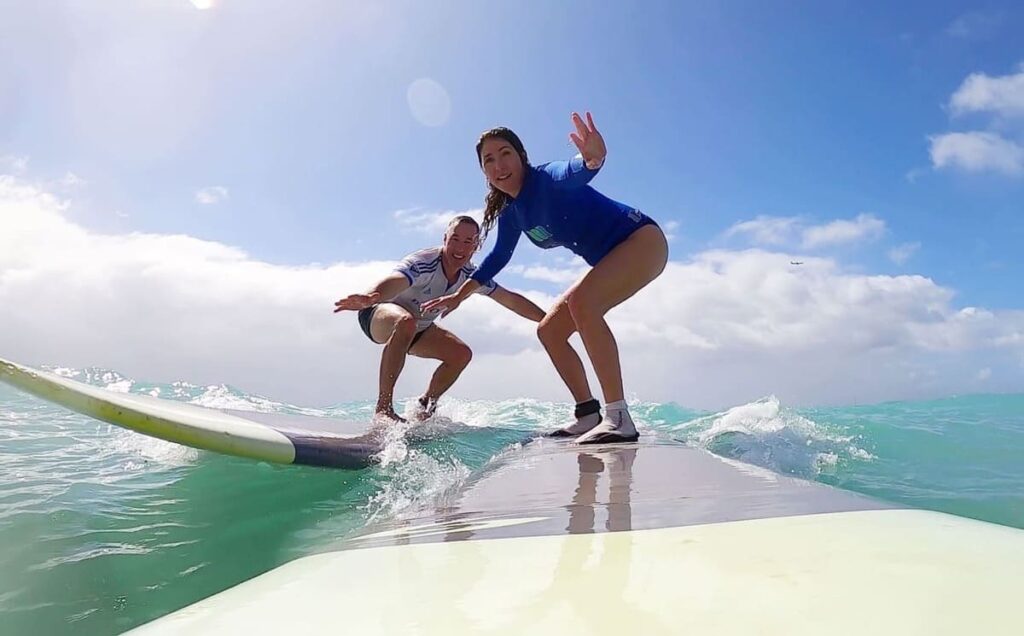
Explore Uncharted Hawaiian Destinations
Booking Lessons in Advance
Plan ahead and make reservations
To secure your spot in a reputable surf school, it’s advisable to plan ahead and make reservations in advance. Popular surf schools can fill up quickly, especially during peak times, so booking ahead ensures you won’t miss out on the opportunity to learn how to surf. Additionally, booking in advance allows you to better plan your trip itinerary and allocate specific days for your surfing lessons.
Determine the number of lessons
The number of lessons you book will depend on your availability, budget, and desired level of proficiency. Beginners typically start with a series of lessons to gain a solid foundation of surfing skills. Discuss your goals and expectations with the surf school, and they can recommend an appropriate number of lessons for you. Keep in mind that learning to surf takes time and practice, so booking multiple lessons will give you the best chance of progressing as a surfer.
Discuss the best learning options
When booking your surf lessons, it’s essential to discuss the learning options with the surf school. Some schools offer group lessons, which can be a great way to learn alongside other beginners and create a sense of camaraderie. However, if you prefer more individualized attention, you may opt for private or semi-private lessons. Discuss your preferences with the surf school and they can advise you on the best learning options that align with your needs and learning style.
Confirm availability and schedules
Once you’ve chosen a surf school and decided on the number of lessons and learning options, it’s crucial to confirm the availability and schedules. Ensure that the surf school has the desired dates and times available for your lessons. This step will prevent any scheduling conflicts and help you finalize your itinerary. Additionally, double-check the cancellation policy and inquire about any necessary deposits or fees to secure your reservations.
Understanding the Equipment
Learn about different surfboard types
Before hitting the waves, it’s important to familiarize yourself with the different types of surfboards. Various surfboard shapes and sizes are designed to accommodate different skill levels and surfing conditions. As a beginner, you’ll typically start with a longboard, which provides stability and ease of paddling. Understanding the characteristics of different surfboard types will help you choose the right equipment for your learning journey.
Know the appropriate board size
Choosing the appropriate surfboard size is crucial for your learning experience. A board that is too small or too big can hinder your progress and make it more challenging for you to catch and ride waves. Generally, beginners benefit from using longer and wider boards as they provide better stability and glide. Consult with your surf school or a knowledgeable surf shop to determine the right board size based on your weight, height, and skill level.
Familiarize yourself with the leash and wax
Two essential accessories that every surfer should be familiar with are the leash and wax. A leash is a cord that attaches to your ankle and the surfboard, ensuring that you don’t lose your board when you fall off. Wax, on the other hand, is applied to the surface of the board to increase traction and prevent slipping. Properly attaching the leash to your ankle and applying wax to your board are important steps for maximizing safety and performance while surfing.
Understand the importance of proper equipment
Understanding the importance of using proper equipment is essential for your safety and enjoyment while learning to surf. Investing in a good quality surfboard, leash, and wax will make your learning experience more enjoyable. Poorly maintained or unsuitable equipment can jeopardize your safety and hinder your progress. Consult with your surf school or local experts to ensure you have the appropriate gear for your level of experience and the current surfing conditions.
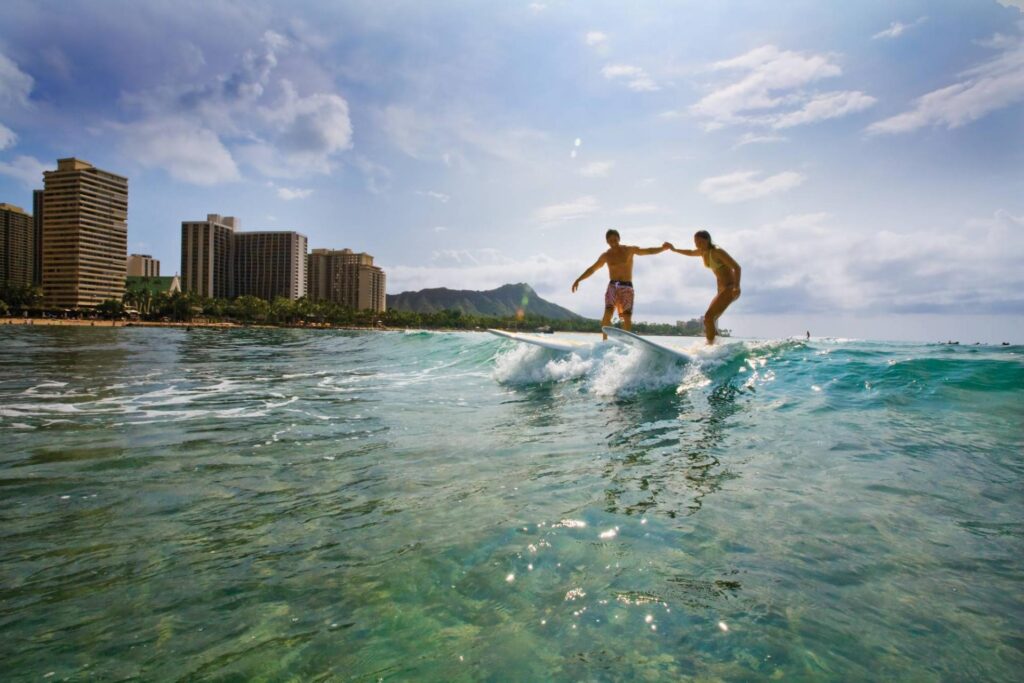
Plan Your Dream Hawaiian Getaway
Mastering Safety Precautions
Learn how to assess surf conditions
One of the most crucial aspects of surfing safely is learning how to assess surf conditions. Before heading into the water, take the time to observe the waves, currents, and general conditions of the ocean. Identify potential hazards such as reefs, rocks, or strong currents. Understanding how to read the surf conditions will help you make informed decisions about whether it’s suitable for your skill level and when to avoid certain areas.
Understand rip currents and tidal changes
Rip currents are strong narrow channels of water that flow away from the shore. It’s essential to educate yourself about rip currents and how to handle them if caught in one. Learning how to identify and navigate rip currents can prevent dangerous situations while surfing. Additionally, understanding tidal changes is crucial as they can significantly impact wave size, currents, and overall surf conditions. Stay informed about the tides and plan your surf sessions accordingly.
Practice basic surfing etiquette
Surfing etiquette is a set of unwritten rules that govern the behavior and respect among surfers in the water. It’s important to learn and practice basic surfing etiquette to ensure a safe and positive surfing experience for yourself and others. Understanding right of way rules, not dropping in on other surfers’ waves, and being respectful and courteous to fellow surfers are essential aspects of surfing etiquette. By adhering to these principles, you’ll contribute to a harmonious surfing community and avoid unnecessary conflicts in the water.
Wear appropriate safety gear
To maximize safety while surfing, it’s crucial to wear appropriate safety gear. This includes a well-fitted and rated surf helmet, a snug-fitting rash guard or wetsuit to protect your skin from the sun and potential scratches, and surf booties to protect your feet from sharp rocks or reef. Wearing safety gear not only provides protection but also enhances your overall comfort and confidence in the water. Prioritize your safety by investing in high-quality safety gear designed specifically for surfing.
Start with Beginner-Friendly Spots
Look for gentle and consistent waves
As a beginner, it’s important to start your surfing journey at beginner-friendly spots with gentle and consistent waves. These types of waves are easier to paddle into and provide a more forgiving learning environment. Look for beaches with sandy bottoms, as these are generally safer for falls and offer a soft landing. Research the local surf spots or consult with your surf school to identify the best beginner-friendly beaches suitable for your skill level.
Avoid reefs and crowded surf breaks
While reefs may offer excellent waves for more experienced surfers, they can be dangerous for beginners due to their shallow and rocky nature. It’s best to avoid surf breaks with reefs until you have gained more experience and confidence in riding waves. Additionally, crowded surf breaks may not be ideal for beginners as they can be overwhelming and increase the chances of accidents or collisions. Opt for less crowded surf spots where you can focus on learning and improving without feeling pressured or rushed.
Choose beaches with sandy bottoms
When selecting beginner-friendly surf spots, beaches with sandy bottoms are highly recommended. With sandy bottoms, the risk of injuries from sharp rocks or coral reefs is minimized. Falling off your board or getting wiped out by a wave on a sandy bottom beach is generally safer compared to rocky or reef-infested areas. Safety should be a top priority, especially when starting out as a beginner, so choose surf spots with sandy bottoms whenever possible.
Consider nearby surf spots for progression
While it’s important to start at beginner-friendly spots, it’s also beneficial to consider nearby surf spots for your progression as you gain more experience. Once you’ve developed more confidence and proficiency in surfing, you can gradually explore intermediate surf spots with slightly larger waves and more challenging conditions. This progressive approach allows for a natural advancement of skills and ensures a safe and enjoyable surfing journey.
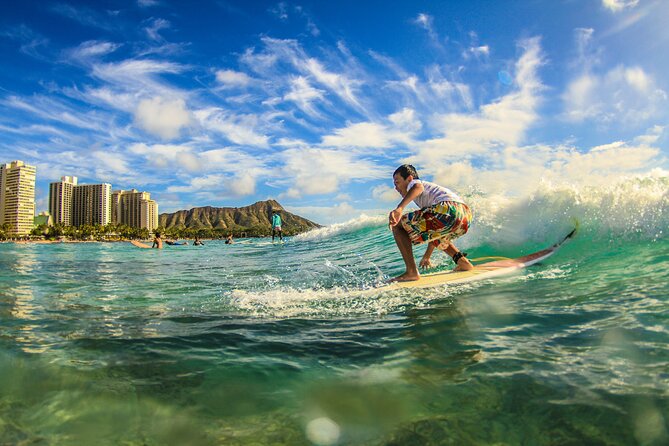
Experience Hawaii’s Unique Attractions
Learning the Basic Techniques
Master the correct paddling technique
Paddling is a fundamental skill in surfing, as it allows you to catch waves and maintain control of your surfboard. Mastering the correct paddling technique will greatly enhance your overall surfing experience. Focus on using your arms, shoulders, and core muscles to paddle efficiently. Keep your chest high on the board and maintain a steady rhythm to generate enough forward momentum. A strong paddling technique will enable you to catch waves more effectively and conserve energy during longer surf sessions.
Practice proper body positioning on the board
Body positioning on the board is essential for stability and control while surfing. As a beginner, focus on lying flat on your surfboard with your chest centered, keeping your weight balanced. Positioning your body slightly forward allows you to maintain control and easily maneuver the board. Avoid placing too much weight on the tail of the board, as this can cause instability and make it harder to catch waves. Practice the correct body positioning on land before heading into the water to build muscle memory and improve your overall technique.
Learn how to catch and ride small waves
As a beginner, it’s important to start with small waves that are easier to catch and ride. Learning how to catch a wave involves timing, paddling with enough speed, and positioning yourself correctly. Once you’ve caught a wave, focus on popping up smoothly from your paddling position to a standing position on the board. Maintaining balance and stability as you ride the wave is crucial. Start with small waves and gradually progress to larger ones as you become more comfortable and confident in your ability to catch and ride waves.
Understand the art of balance and foot placement
Balance is a vital component of surfing. Developing a good sense of balance allows you to stay on your board and ride waves with control. Focus on distributing your weight evenly on the board, keeping your knees slightly bent for stability. Proper foot placement is also important for balance and control. As a beginner, practice placing your feet in the middle of the board, shoulder-width apart, with your toes pointing slightly towards the front of the board. Fine-tuning your balance and foot placement will greatly improve your surfing skills.
Taking Advantage of Surf Camps
Immerse yourself in a surfing environment
Surf camps provide a unique opportunity to fully immerse yourself in a surfing environment. By choosing to stay at a surf camp, you’ll be surrounded by like-minded individuals who share your passion for surfing. This immersion allows for continuous exposure to surfing culture, additional practice opportunities, and a supportive community of fellow surf enthusiasts. Living and breathing surfing during your stay at a surf camp can greatly accelerate your learning and help you fully embrace the surfing lifestyle.
Benefit from structured lessons and progression
One of the main advantages of surf camps is the structured approach to lessons and progression. Surf camps typically offer comprehensive programs and schedules designed to cater to different skill levels. With experienced instructors guiding your learning process, you’ll follow a well-curated curriculum that emphasizes skill development and progression. Structured lessons provide a clear path towards improving your surfing technique, advancing to higher levels, and achieving your surfing goals.
Engage with fellow surf enthusiasts
Surf camps are not only about learning to surf but also about connecting with fellow surf enthusiasts. Sharing experiences, exchanging tips and stories, and bonding over a common love for the ocean and waves create a vibrant and supportive community. Engaging with fellow surf enthusiasts can inspire and motivate you to push your limits, try new techniques, and celebrate each other’s milestones. The friendships and connections forged at surf camps often extend beyond the duration of your stay, fostering a lifelong love for surfing and the ocean.
Join specialized surf training programs
Surf camps often offer specialized surf training programs for those looking to take their skills to the next level. These programs focus on specific aspects of surfing such as advanced maneuvers, competitive surfing, or even surf coaching. If you’re interested in honing specific techniques or pursuing a particular surfing discipline, joining these specialized programs can provide invaluable guidance and training. Consult with the surf camp you’re considering to see if they offer any specialized programs that align with your surfing goals and interests.
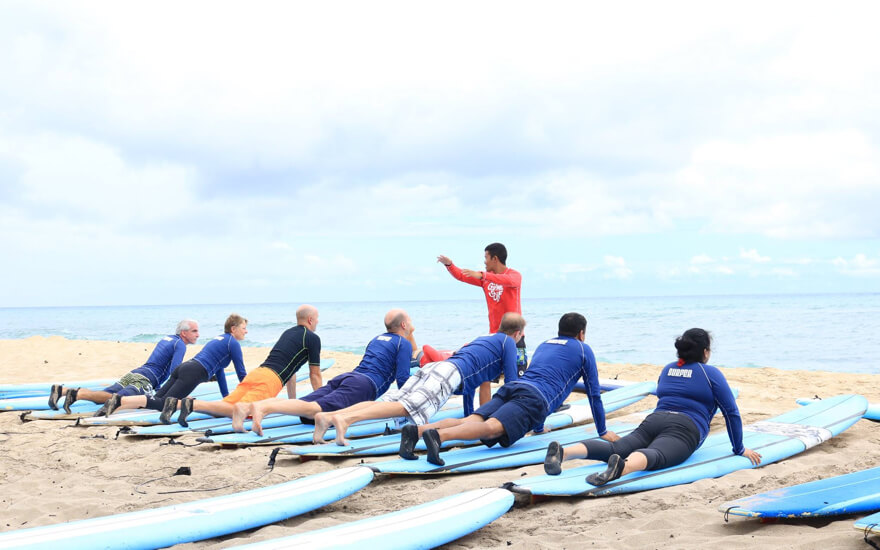
Honing Skills through Practice
Allocate regular time for practice
Learning to surf requires consistent practice and repetition. To progress as a surfer, it’s important to allocate regular time for practice. Set aside dedicated time each week to get in the water, practice your skills, and build muscle memory. Consistency is key when it comes to surfing, and even short practice sessions multiple times a week can lead to significant improvement. Make surfing a priority and commit to regular practice to bolster your skills and enhance your overall surfing ability.
Focus on improving balance and coordination
Improving balance and coordination is crucial for advancing your surfing skills. Allocate practice time to specific exercises that target these areas. Incorporate balance drills, such as standing on a balance board or practicing yoga poses, to develop a strong sense of balance. Additionally, engage in activities that improve overall coordination, such as skateboarding or paddleboarding. By focusing on these aspects during practice, you’ll develop the skills necessary for maneuverability, control, and mastering more advanced surfing techniques.
Gradually progress to larger waves
As you gain more experience and confidence in your surfing abilities, it’s essential to gradually progress to larger waves. Start by challenging yourself with slightly bigger waves that still offer a safe and manageable learning environment. Progressing to larger waves allows you to refine your skills, develop wave-reading abilities, and experience different surfing conditions. However, always ensure you have the necessary skills and experience before attempting to surf in more challenging conditions. Surfing beyond your abilities can be dangerous, so progress at a pace that aligns with your comfort and skill level.
Experiment with different surfboard sizes
As your surfing skills improve, it’s worth experimenting with different surfboard sizes to enhance your overall performance. Trying out different board shapes, lengths, and volumes can help you fine-tune your surfing style and adapt to a variety of wave conditions. Smaller boards offer increased maneuverability and responsiveness, while larger boards provide stability and glide. Consult with experienced surfers or experts at surf shops to determine which surfboard sizes complement your skill level and desired style of surfing. By exploring a variety of surfboard options, you’ll gain a better understanding of what works best for you and improve your ability to handle different wave conditions.
Respecting the Ocean and Environment
Practice proper waste management
Respecting the ocean and the environment is essential for every surfer. Play your part in keeping the oceans clean, and practice proper waste management. Avoid leaving any trash or litter on the beach, and use designated trash bins to dispose of waste. Consider bringing a reusable water bottle and snacks to minimize single-use plastic waste. By taking responsibility for your own waste and encouraging others to do the same, you contribute to the preservation of the beautiful natural environments that enable us to enjoy the sport of surfing.
Avoid harming marine life and coral reefs
While enjoying the ocean, it’s important to be mindful of the marine life and coral reefs that inhabit these ecosystems. Avoid activities that can harm marine life, such as stepping on or touching coral reefs, and maintain a safe distance from marine creatures. Take extra caution to avoid coral contact, as it is fragile and sensitive to disturbance. By respecting and preserving these ecosystems, you contribute to the overall health and sustainability of the ocean and its inhabitants.
Educate yourself about local conservation efforts
Before visiting a surf destination, take the time to educate yourself about local conservation efforts. Many coastal communities and organizations actively work towards the protection and preservation of their local surfing spots and marine environments. Research local conservation initiatives and ways you can get involved, such as participating in beach clean-ups or supporting organizations dedicated to marine conservation. By engaging with and supporting these efforts, you contribute to the long-term sustainability of the ocean and ensure that future generations can enjoy the wonder of surfing.
Leave only footprints and take memories
As a responsible surfer, leave only footprints when visiting the beach and take only memories with you. Avoid taking any natural souvenirs, such as shells, rocks, or coral, as these are essential components of the coastal ecosystems. These natural treasures play vital roles in maintaining the ecological balance of the beach and the ocean. By appreciating the beauty of nature without disturbing its delicate balance, you can help preserve the integrity of surf destinations for generations to come.
Learning to surf in Hawaii offers a unique experience to immerse yourself in the world of waves and embrace the surfing culture that the islands have to offer. By choosing the right time to visit, selecting the ideal surf school, booking lessons in advance, understanding the equipment, mastering safety precautions, starting with beginner-friendly spots, learning the basic techniques, taking advantage of surf camps, honing skills through practice, and respecting the ocean and environment, you can embark on a fulfilling surfing journey. Remember, learning to surf takes time, patience, and dedication, but the rewards of riding your first wave and embracing the thrill of surfing make it all worth it. So, get ready to paddle out, catch some waves, and embark on your surfing adventure in beautiful Hawaii!
